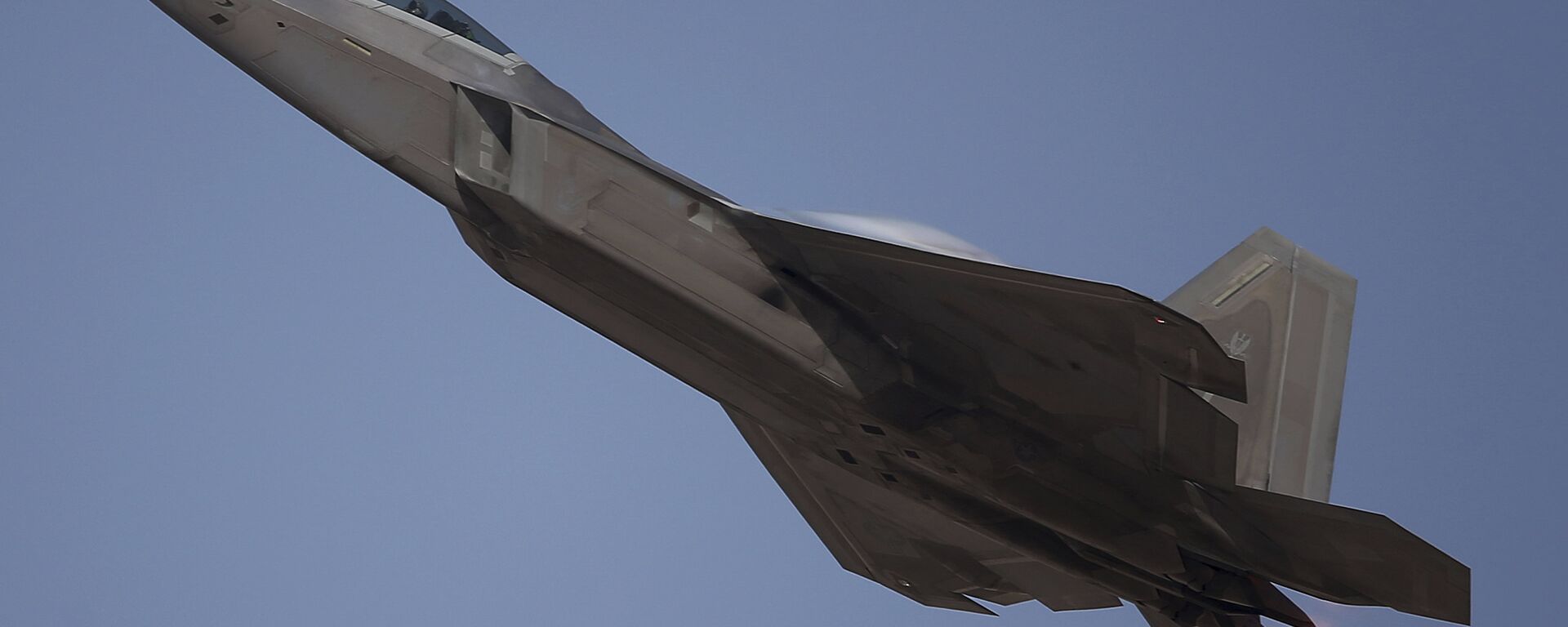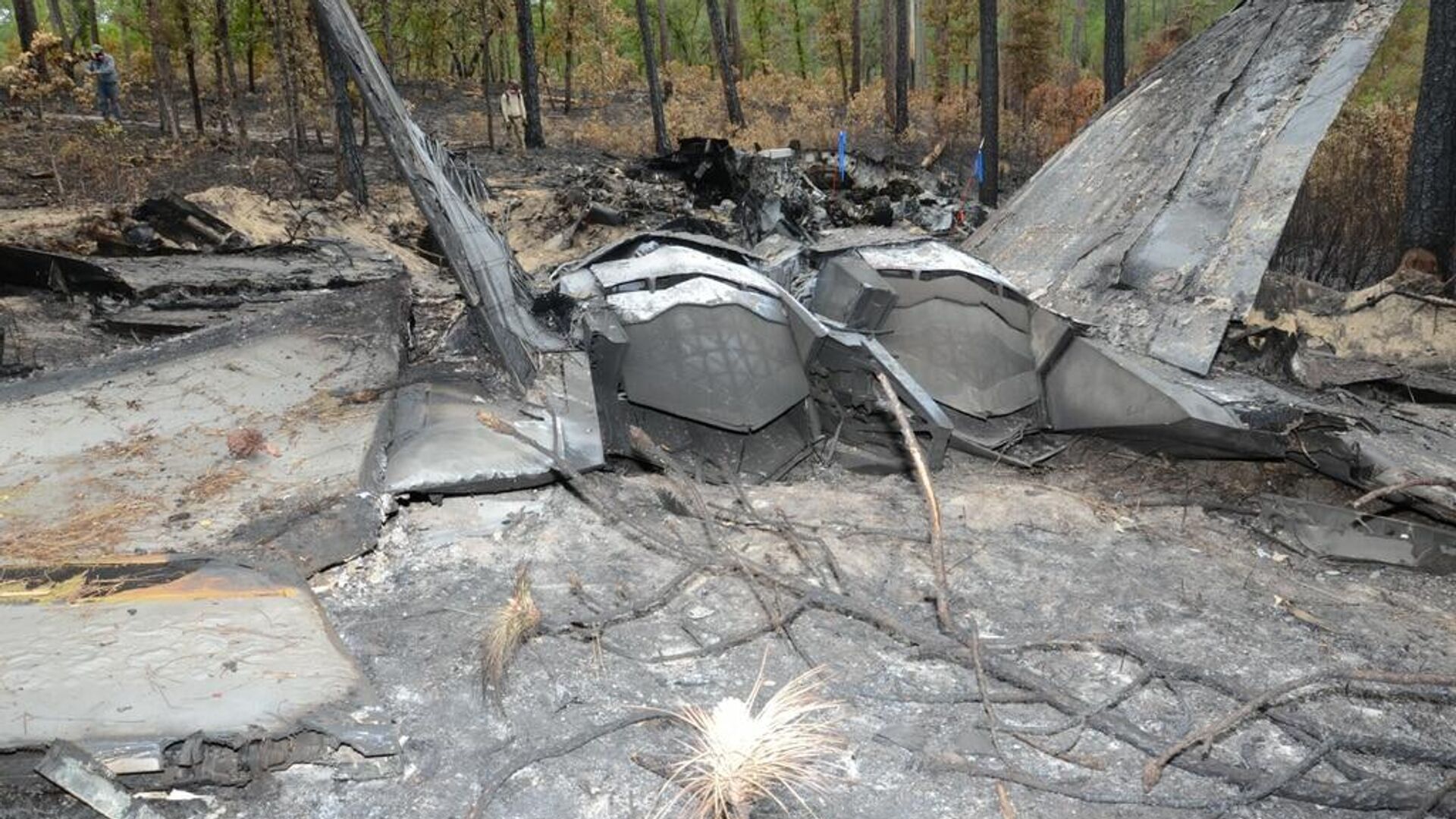https://sputnikglobe.com/20211016/f-22s-f-35s-nearly-collided-while-looking-for-raptor-that-crashed-from-improper-washing-1089972716.html
F-22s, F-35s Nearly Collided While Looking for Raptor That Crashed From ‘Improper Washing’
F-22s, F-35s Nearly Collided While Looking for Raptor That Crashed From ‘Improper Washing’
Sputnik International
An Air Force Lockheed Martin F-22 Raptor stealth fighter from the 43rd Fighter Squadron went down about 20 km northeast of Eglin Air Force Base in western... 16.10.2021, Sputnik International
2021-10-16T14:03+0000
2021-10-16T14:03+0000
2021-10-16T18:10+0000
f-22
eglin air force base
https://cdn1.img.sputnikglobe.com/img/07e5/0a/10/1089972671_0:51:1025:627_1920x0_80_0_0_e507624fe0c73905dd046c08efefa5e6.jpg
The Air Force Times has received documents from a safety board probe into the May 2020 F-22 crash, elaborating on the service’s admission in August that the fifth-gen $201 million plane went down due to a “maintenance error made after the aircraft was washed” which “impacted control inputs transmitted to the aircraft.”According to the documents, provided to the Air Force Times through a Freedom of Information Act request, piloting the ill-fated F-22 became a nightmare after the wash, with the aircraft eventually proving unable to perform a left turn, wobbling, and ultimately barrel rolling into the ground about 20 km northeast of the base where it was stationed after its pilot ejected.The problems reportedly started immediately after takeoff, with a cockpit warning light flashing and the jet beginning to roll to the left uncontrollably. The pilot throttled back the engines and leveled out as a wingman gave them a visual inspection. Shortly after, a second warning light began flashing signaling degraded air data and rolling left again and pitching down, leaving the plane in an “almost inverted” state – according to the wingman.“I thought that I was out of control at that point and was concerned that I might have to eject right there,” the pilot told investigators. He decided to press on, however, after regaining control. Shortly after, a third warning light flashed indicating that the aircraft was in danger of becoming overstressed by g-forces.At that point, the pilot turned back and set a course for Eglin, but never made it after the plane lost the ability to turn left, required strong pressure to keep level, and showed faulty altitude and speed readings.Near Midair CollisionThe documents also revealed that an Air Force mission to find the crash site and pilot nearly ended in disaster itself after F-22s and F-35 Lightning IIs almost collided into one another in midair during the chaotic search operation.According to the accident report, F-35s were scrambled to the scene of the accident to relay coordinates for search-and-rescue forces, but none were to be found, with a local tour helicopter also making its way to help find the pilot, but turned back after he informed local officials that he was ok, aside from sore calves and scratches on his hands.The Air Force estimates that the F-22 crash resulted in over $202 million in losses, including the $201.6 million plane itself, plus a pair of CATM-9 training missiles and $850,000 in environmental cleanup bills.Lockheed Martin and other defence companies reportedly spoke to investigators as well, but whatever input they had was not publicised in the trove of papers provided to the Air Force Time. An Air Force spokesman did not respond to a request for comment on whether other aircraft in the service’s F-22 fleet may be vulnerable to the same problems.The 43rd Fighter Squadron in which the ill-fated F-22 served was part of the 325th Fighter Wing, which relocated to Eglin Air Force Base in 2018 after Hurricane Michael destroyed Tyndall Air Force Base – the wing’s original home.Eglin’s 43rdFighter Squadron’s jets have repeatedly come up in the news over their tendency to become involved in accidents. Several days after the F-22 crash in May 2020, an F-35 from the squadron was lost on a routine night training sortie. Its pilot ejected successfully.In March of 2021, another F-22 made an emergency nose-down landing on the runway at Eglin following an in-flight emergency. That incident followed two emergencies in 2018 at Naval Air Station Fallon in Nevada and Elmendorf Air Force Base in Alaska, which saw F-22s scraping the tarmac with their fuselages. Also in 2018, another F-22 suffered catastrophic engine failure while flying out of Tyndall Air Force Base before it was wiped out by the hurricane.In May, the Air Force revealed that it was planning to scrap its entire stock of F-22 Raptors and replace them with a mystery plane, drone or drone plane being developed under the "Next Generation Air Dominance" programme sometime in the 2030s. The Air Force pointed to the planes' age, small numbers, growing cost of operation, increasingly sophisticated enemy air defences, and a lack of spare parts as factors pushing the planes toward retirement.Last month, US media reported that the Air Force has recommended building an export, monkey model version of the jet and selling it to foreign customers.The Air Force has more than 180 operational F-22s in its inventory, with their average age being just 12 years old. The planes have a combined lifecycle cost of a whopping $678 million per plane, and until the arrival of the F-35 and its estimated $1.7 trillion lifetime cost, were considered the most expensive airframes ever built. The planes have been deployed in Alaska, Germany and Eastern Europe, and used on a limited bases in the US operations in Syria and Afghanistan. They have never been used to shoot down an enemy plane in combat – their primary mission as outlined when the jet’s development began in the 1980s.
https://sputnikglobe.com/20210918/us-air-force-reveals-conditions-to-lift-decades-long-ban-on-f-22-raptor-exports-1089191776.html
Sputnik International
feedback@sputniknews.com
+74956456601
MIA „Rossiya Segodnya“
2021
News
en_EN
Sputnik International
feedback@sputniknews.com
+74956456601
MIA „Rossiya Segodnya“
Sputnik International
feedback@sputniknews.com
+74956456601
MIA „Rossiya Segodnya“
f-22, eglin air force base
f-22, eglin air force base
F-22s, F-35s Nearly Collided While Looking for Raptor That Crashed From ‘Improper Washing’
14:03 GMT 16.10.2021 (Updated: 18:10 GMT 16.10.2021) An Air Force Lockheed Martin F-22 Raptor stealth fighter from the 43rd Fighter Squadron went down about 20 km northeast of Eglin Air Force Base in western Florida on 15 May 2020 while taking part in a training exercise. The pilot managed to eject and walked away from the crash unharmed.
The Air Force Times has received documents from a safety board probe into the May 2020 F-22 crash, elaborating on the service’s
admission in August that the fifth-gen $201 million plane went down due to a “maintenance error made after the aircraft was washed” which “impacted control inputs transmitted to the aircraft.”
According to the
documents, provided to the Air Force Times through a Freedom of Information Act request, piloting the ill-fated F-22 became a nightmare after the wash, with the aircraft eventually proving unable to perform a left turn, wobbling, and ultimately barrel rolling into the ground about 20 km northeast of the base where it was stationed after its pilot ejected.
The problems reportedly started immediately after takeoff, with a cockpit warning light flashing and the jet beginning to roll to the left uncontrollably. The pilot throttled back the engines and leveled out as a wingman gave them a visual inspection. Shortly after, a second warning light began flashing signaling degraded air data and rolling left again and pitching down, leaving the plane in an “almost inverted” state – according to the wingman.
“I thought that I was out of control at that point and was concerned that I might have to eject right there,” the pilot told investigators. He decided to press on, however, after regaining control. Shortly after, a third warning light flashed indicating that the aircraft was in danger of becoming overstressed by g-forces.
At that point, the pilot turned back and set a course for Eglin, but never made it after the plane lost the ability to turn left, required strong pressure to keep level, and showed faulty altitude and speed readings.
The documents also revealed that an Air Force mission to find the crash site and pilot nearly ended in disaster itself after F-22s and F-35 Lightning IIs almost collided into one another in midair during the chaotic search operation.
“There were multiple [air traffic control] agencies that I believe were attempting to help using their best judgement, but the airspace over the crash site actually got saturated and became…fairly dangerous,” an instructor with 43rdFighter Squadron serving as flying supervisor told investigators. The supervisor said the close call was a lesson for any future efforts to coordinate an emergency response.
According to the accident report, F-35s were scrambled to the scene of the accident to relay coordinates for search-and-rescue forces, but none were to be found, with a local tour helicopter also making its way to help find the pilot, but turned back after he informed local officials that he was ok, aside from sore calves and scratches on his hands.
The Air Force estimates that the F-22 crash resulted in over $202 million in losses, including the $201.6 million plane itself, plus a pair of CATM-9 training missiles and $850,000 in environmental cleanup bills.
Lockheed Martin and other defence companies reportedly spoke to investigators as well, but whatever input they had was not publicised in the trove of papers provided to the Air Force Time. An Air Force spokesman did not respond to a request for comment on whether other aircraft in the service’s F-22 fleet may be vulnerable to the same problems.
The 43rd Fighter Squadron in which the ill-fated F-22 served was part of the 325th Fighter Wing, which relocated to Eglin Air Force Base in 2018 after Hurricane Michael destroyed Tyndall Air Force Base – the wing’s original home.
Eglin’s 43rdFighter Squadron’s jets have repeatedly come up in the news over their tendency to become involved in accidents. Several days after the F-22 crash in May 2020, an F-35 from the squadron
was lost on a routine night training sortie. Its pilot ejected successfully.
In March of 2021, another F-22
made an emergency nose-down landing on the runway at Eglin following an in-flight emergency. That incident followed two emergencies in 2018 at Naval Air Station Fallon in Nevada and Elmendorf Air Force Base in Alaska, which saw F-22s scraping the tarmac with their fuselages. Also in 2018, another F-22 suffered catastrophic engine failure while flying out of Tyndall Air Force Base before it was wiped out by the hurricane.
In May, the Air Force
revealed that it was planning to scrap its entire stock of F-22 Raptors and replace them with a mystery plane, drone or drone plane being developed under the "Next Generation Air Dominance" programme sometime in the 2030s. The Air Force pointed to the planes' age, small numbers, growing cost of operation, increasingly sophisticated enemy air defences, and a lack of spare parts as factors pushing the planes toward retirement.

18 September 2021, 20:00 GMT
Last month, US media
reported that the Air Force has recommended building an export, monkey model version of the jet and selling it to foreign customers.
The Air Force has more than 180 operational F-22s in its inventory, with their average age being just 12 years old. The planes have a combined lifecycle cost of a whopping
$678 million per plane, and until the arrival of the F-35 and its estimated
$1.7 trillion lifetime cost, were considered the most expensive airframes ever built. The planes have been deployed in Alaska, Germany and Eastern Europe, and used on a limited bases in the US operations in Syria and Afghanistan. They have never been used to shoot down an enemy plane in combat – their primary mission as outlined when the jet’s development began in the 1980s.


